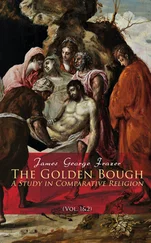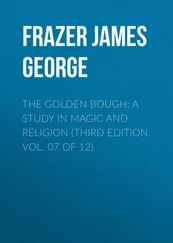James Frazer - The Golden Bough - A Study in Comparative Religion (Vol. 1 of 2)
Здесь есть возможность читать онлайн «James Frazer - The Golden Bough - A Study in Comparative Religion (Vol. 1 of 2)» — ознакомительный отрывок электронной книги совершенно бесплатно, а после прочтения отрывка купить полную версию. В некоторых случаях можно слушать аудио, скачать через торрент в формате fb2 и присутствует краткое содержание. Жанр: foreign_religion, foreign_antique, foreign_prose, на английском языке. Описание произведения, (предисловие) а так же отзывы посетителей доступны на портале библиотеки ЛибКат.
- Название:The Golden Bough: A Study in Comparative Religion (Vol. 1 of 2)
- Автор:
- Жанр:
- Год:неизвестен
- ISBN:нет данных
- Рейтинг книги:4 / 5. Голосов: 1
-
Избранное:Добавить в избранное
- Отзывы:
-
Ваша оценка:
- 80
- 1
- 2
- 3
- 4
- 5
The Golden Bough: A Study in Comparative Religion (Vol. 1 of 2): краткое содержание, описание и аннотация
Предлагаем к чтению аннотацию, описание, краткое содержание или предисловие (зависит от того, что написал сам автор книги «The Golden Bough: A Study in Comparative Religion (Vol. 1 of 2)»). Если вы не нашли необходимую информацию о книге — напишите в комментариях, мы постараемся отыскать её.
The Golden Bough: A Study in Comparative Religion (Vol. 1 of 2) — читать онлайн ознакомительный отрывок
Ниже представлен текст книги, разбитый по страницам. Система сохранения места последней прочитанной страницы, позволяет с удобством читать онлайн бесплатно книгу «The Golden Bough: A Study in Comparative Religion (Vol. 1 of 2)», без необходимости каждый раз заново искать на чём Вы остановились. Поставьте закладку, и сможете в любой момент перейти на страницу, на которой закончили чтение.
Интервал:
Закладка:
Like other peoples the Greeks and Romans sought to procure rain by magic, when prayers and processions 80 80 Marcus Antoninus, v. 7; Petronius, 44; Tertullian, Apolog. 40; cp. id. 22 and 23.
had proved ineffectual. For example, in Arcadia, when the corn and trees were parched with drought, the priest of Zeus dipped an oak branch into a certain spring on Mount Lycaeus. Thus troubled, the water sent up a misty cloud, from which rain soon fell upon the land. 81 81 Pausanias, viii. 38, 4.
A similar mode of making rain is still practised, as we have seen, in Halmahera near New Guinea. The people of Crannon in Thessaly had a bronze chariot which they kept in a temple. When they desired a shower they shook the chariot and the shower fell. 82 82 Antigonus, Histor. Mirab. 15 ( Script. mirab. Graeci , ed. Westermann, p. 65).
Probably the rattling of the chariot was meant to imitate thunder; we have already seen that in Russia mock thunder and lightning form part of a rain-charm. The mythical Salmoneus of Thessaly made mock thunder by dragging bronze kettles behind his chariot or by driving over a bronze bridge, while he hurled blazing torches in imitation of lightning. It was his impious wish to mimic the thundering car of Zeus as it rolled across the vault of heaven. 83 83 Apollodorus, Bibl. i. 9, 7; Virgil, Aen. vi. 585 sqq. ; Servius on Virgil, l. c.
Near a temple of Mars, outside the walls of Rome, there was kept a certain stone known as the lapis manalis . In time of drought the stone was dragged into Rome and this was supposed to bring down rain immediately. 84 84 Festus, svv. aquaelicium and manalem lapidem , pp. 2, 128, ed. Müller; Nonius Marcellus, sv. trullum , p. 637, ed. Quicherat; Servius on Virgil, Aen. iii. 175; Fulgentius, Expos. serm. antiq. , sv. manales lapides, Mythogr. Lat. ed. Staveren, p. 769 sq.
There were Etruscan wizards who made rain or discovered springs of water, it is not certain which. They were thought to bring the rain or the water out of their bellies. 85 85 Nonius Marcellus, sv. aquilex , p. 69, ed. Quicherat. In favour of taking aquilex as rain-maker is the use of aquaelicium in the sense of rain-making. Cp. K. O. Müller, Die Etrusker , ed. W. Deecke, ii. 318 sq.
The legendary Telchines in Rhodes are described as magicians who could change their shape and bring clouds, rain, and snow. 86 86 Diodorus, v. 55.
Again, primitive man fancies he can make the sun to shine, and can hasten or stay its going down. At an eclipse the Ojebways used to think that the sun was being extinguished. So they shot fire-tipped arrows in the air, hoping thus to rekindle his expiring light. 87 87 Peter Jones, History of the Ojebway Indians , p. 84.
Conversely during an eclipse of the moon some Indian tribes of the Orinoco used to bury lighted brands in the ground; because, said they, if the moon were to be extinguished, all fire on earth would be extinguished with her, except such as was hidden from her sight. 88 88 Gumilla, Histoire de l'Orénoque , iii. 243 sq.
In New Caledonia when a wizard desires to make sunshine, he takes some plants and corals to the burial-ground, and makes them into a bundle, adding two locks of hair cut from a living child (his own child if possible), also two teeth or an entire jawbone from the skeleton of an ancestor. He then climbs a high mountain whose top catches the first rays of the morning sun. Here he deposits three sorts of plants on a flat stone, places a branch of dry coral beside them, and hangs the bundle of charms over the stone. Next morning he returns to this rude altar, and at the moment when the sun rises from the sea he kindles a fire on the altar. As the smoke rises, he rubs the stone with the dry coral, invokes his ancestors and says: “Sun! I do this that you may be burning hot, and eat up all the clouds in the sky.” The same ceremony is repeated at sunset. 89 89 Glaumont, “Usages, mœurs et coutumes des Néo-Calédoniens,” in Revue d' Ethnographie , vi. 116.
When the sun rises behind clouds – a rare event in the bright sky of Southern Africa – the Sun clan of the Bechuanas say that he is grieving their heart. All work stands still, and all the food of the previous day is given to matrons or old women. They may eat it and may share it with the children they are nursing, but no one else may taste it. The people go down to the river and wash themselves all over. Each man throws into the river a stone taken from his domestic hearth, and replaces it with one picked up in the bed of the river. On their return to the village the chief kindles a fire in his hut, and all his subjects come and get a light from it. A general dance follows. 90 90 Arbousset et Daumas, Voyage d'exploration au Nord-est de la Colonie du Cap de Bonne-Espérance , p. 350 sq. For the kinship with the sacred object (tchem) from which the clan takes its name, see ib. pp. 350, 422, 424. Other people have claimed kindred with the sun, as the Natchez of North America ( Voyages au Nord , v. 24) and the Incas of Peru.
In these cases it seems that the lighting of the flame on earth is supposed to rekindle the solar fire. Such a belief comes naturally to people who, like the Sun clan of the Bechuanas, deem themselves the veritable kinsmen of the sun. The Melanesians make sunshine by means of a mock sun. A round stone is wound about with red braid and stuck with owl's feathers to represent rays; it is then hung on a high tree. Or the stone is laid on the ground with white rods radiating from it to imitate sunbeams. 91 91 Codrington, in Journ. Anthrop. Instit. x. 278.
Sometimes the mode of making sunshine is the converse of that of making rain. Thus we have seen that a white or red pig is sacrificed for sunshine, as a black one is sacrificed for rain. 92 92 Above, p. 18 .
Some of the New Caledonians drench a skeleton to make rain, but burn it to make sunshine. 93 93 Turner, Samoa , p. 346. See above, p. 16 .
In a pass of the Peruvian Andes stand two ruined towers on opposite hills. Iron hooks are clamped into their walls for the purpose of stretching a net from one tower to the other. The net is intended to catch the sun. 94 94 Bastian, Die Völker des östlichen Asien , iv. 174. The name of the place is Andahuayllas.
On the top of a small hill in Fiji grew a patch of reeds, and travellers who feared to be belated used to tie the tops of a handful of reeds together to detain the sun from going down. 95 95 Th. Williams, Fiji and the Fijians , i. 250.
The intention perhaps was to entangle the sun in the reeds, just as the Peruvians try to catch him in the net. Stories of men who have caught the sun in a noose are widely spread. 96 96 Schoolcraft, The American Indians , p. 97 sqq. ; Gill, Myths and Songs of the South Pacific , p. 61 sq. ; Turner, Samoa , p. 200 sq.
Jerome of Prague, travelling among the heathen Lithuanians early in the fifteenth century, found a tribe who worshipped the sun and venerated a large iron hammer. The priests told him that once the sun had been invisible for several months, because a powerful king had shut it up in a strong tower; but the signs of the zodiac had broken open the tower with this very hammer and released the sun. Therefore they adored the hammer. 97 97 Aeneas Sylvius, Opera (Bâle, 1571), p. 418.
When an Australian blackfellow wishes to stay the sun from going down till he gets home, he places a sod in the fork of a tree, exactly facing the setting sun. 98 98 Brough Smyth, Aborigines of Victoria , ii. 334; Curr, The Australian Race , i. 50.
For the same purpose an Indian of Yucatan, journeying westward, places a stone in a tree or pulls out some of his eyelashes and blows them towards the sun. 99 99 Fancourt, History of Yucatan , p. 118.
South African natives, in travelling, will put a stone in a branch of a tree or place some grass on the path with a stone over it, believing that this will cause their friends to keep the meal waiting till their arrival. 100 100 South African Folk-lore Journal , i. 34.
In these, as in previous examples, the purpose apparently is to retard the sun. But why should the act of putting a stone or a sod in a tree be supposed to effect this? A partial explanation is suggested by another Australian custom. In their journeys the natives are accustomed to place stones in trees at different heights from the ground in order to indicate the height of the sun in the sky at the moment when they passed the particular tree. Those who follow are thus made aware of the time of day when their friends in advance passed the spot. 101 101 E. J. Eyre, Journals of Expeditions of Discovery into Central Australia , ii. 365.
Possibly the natives, thus accustomed to mark the sun's progress, may have slipped into the confusion of imagining that to mark the sun's progress was to arrest it at the point marked. On the other hand, to make it go down faster, the Australians throw sand into the air and blow with their mouths towards the sun. 102 102 Curr, The Australian Race , iii. 145.
Интервал:
Закладка:
Похожие книги на «The Golden Bough: A Study in Comparative Religion (Vol. 1 of 2)»
Представляем Вашему вниманию похожие книги на «The Golden Bough: A Study in Comparative Religion (Vol. 1 of 2)» списком для выбора. Мы отобрали схожую по названию и смыслу литературу в надежде предоставить читателям больше вариантов отыскать новые, интересные, ещё непрочитанные произведения.
Обсуждение, отзывы о книге «The Golden Bough: A Study in Comparative Religion (Vol. 1 of 2)» и просто собственные мнения читателей. Оставьте ваши комментарии, напишите, что Вы думаете о произведении, его смысле или главных героях. Укажите что конкретно понравилось, а что нет, и почему Вы так считаете.












